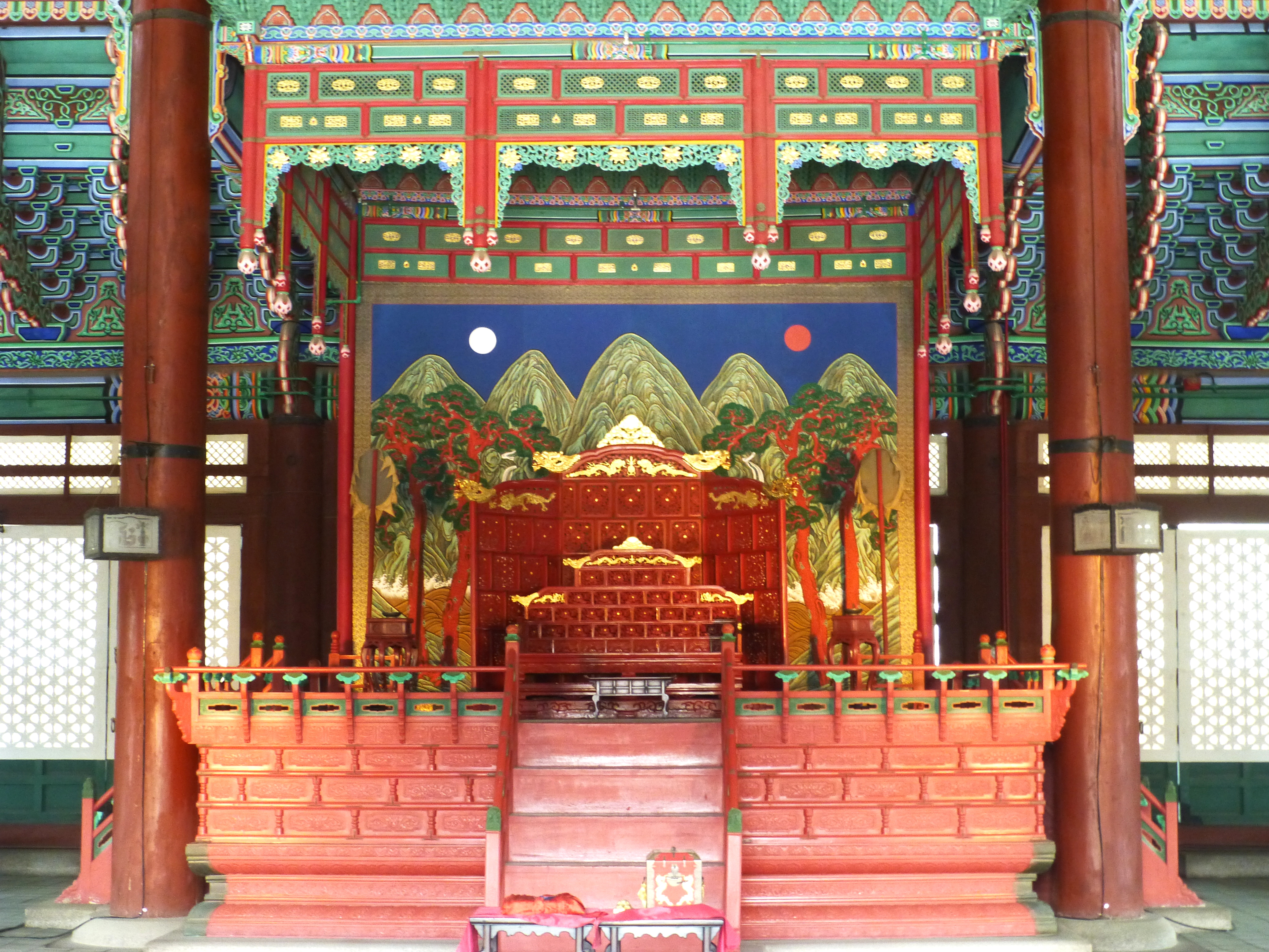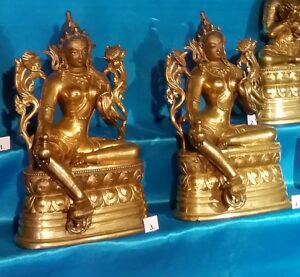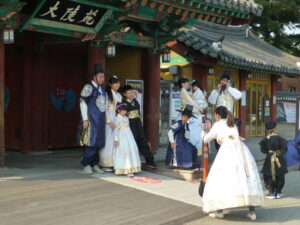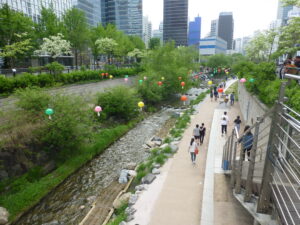In brief: For centuries, the Joseon dynasty ruled Korean. Its traces are many – in the palaces of Seoul, the ancestral home at Jeonju, and a quiet village at Yangdong..

On a chilly, drizzly day we took a bus to the outskirts of medieval Gyeongju and jumped nearly a millenium forward in time to the 15th century – and our first introduction to the long-lasting Joseon dynasty, which endured until 1897.
We were visiting Yangdong, a UNESCO heritage village, whose houses are perched atop several hills, a hearty climb from the valley floor. In those same houses, generation after generation of the Son and Li families have lived for 550 years, back to the early days of the Joseon dynasty when the family founders were local governors. The Son home – Gwangajeong, or “seeing the harvest” – was the family’s main home for four hundred years, with a shrine for honoring ancestors like most of the subsequent houses.
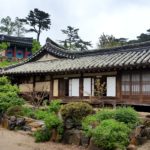
On the hill next door sits the primary Li family home, Mucheomdang, “the house without disgrace to ancestors,” one of the loveliest of the ancient houses at Yangdong.
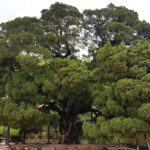
A massive 600 year old cedar tree, planted by the first member of the Son family, still overspreads the yard of one house.
Some 150 other dwellings including many thatch-roofed homes are scattered around them, looking out on other lush green conical hills.
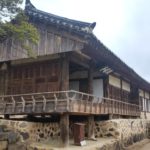
Many tales of honor or mystery live here too. One house, Seobaekdang or “the house of hundred-fold patience,” was prophesied to be the birthplace of three great men, the last of which is still to come.
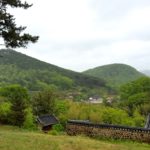
It’s adjacent to the house the one prophesied to witness the birth of three famous sons. Famous scholars and holy men have grown up in them. Another house – as well as a commemorative shrine – was a gift granted to a Li who left a lucrative post so he could take care of his mother. In the cold mists, you could feel the ancestral spirits near.
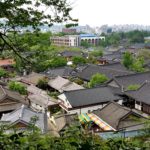
Jeonju, farther north, however, was the ancestral homeland of all the Joseon dynasty kings, descendants of Yi (Lee) Seonggye, the first one.

Past the impressive Pungnammun Gate, the only survivor of the four old entrances to the city, sprawls the Gyeonggijeon Palace, where the rulers lived and worked. Many old and re-created structures still stand.
Gyeonggijeon Palace continues to house the living memories of ancestral royal spirits. Here were kept life-sized portraits of Joseon kings, most of which are on display, most notably Taejo the royal name for Yi Seonggye, the first king. The originals were destroyed long ago, so it’s really a copy of a copy, but still impressive.
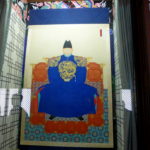
As an assertion of royal power, portraits and memorial tablets were ceremoniously paraded about in long processions of soldiers, palanquins, banners and so on. At the palace, we could view this miniature version of a procession wrapped around a large room.

The tablets and portraits acted as a kind of home base for royal spirits to return in peace and receive the honor of ancestral rites. When not on parade, they sat in the palace behind red gates with spear-like vertical struts. Such gates protected against airborne evil spirits, which fear red and tend to snag their flowing robes on the spear-heads.
The palace also housed the only surviving copy of the meticulously recorded annals of the dynasty’s 500 year reign, some 1,893 volumes. They required sixty chests to transport when they were heroically evacuated to avoid military destruction by invaders. And devastating invasions by Japan over the centuries were notable, forcing the dynasty to recover and rebuilt time and again. Among the further oddities here are monuments marking the site where one heir’s placenta and umbilical cord are buried.
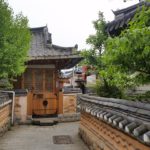
Perhaps even more impressive are the hanoks in Jeonju, around 800 traditional Joseon-dynasty homes arrayed on old narrow lanes that comprise a living museum. Some date back to the origins of the dynasty. It’s not surprising that both Korean and foreign tourists throng the town, often noisily and oppressively so.
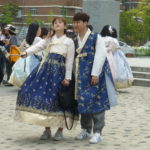
Here too, visitors often dress up in Joseon-style outfits, renting them from the many costume shops. Most retain their own footware: sneakers may not be so authentic, but Koreans seem very pragmatic about shoe-ware, and not slaves to fashion. As a result, the crowded streets become quite colorful and the town a place for endless selfies.

We were able to snoop out some charm in the narrow lanes that weave around the well-preserved houses. And we enjoyed Jeonju’s many showcases for traditional crafts such as music-making and rice wine methods.
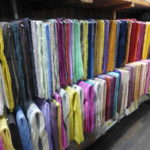
Most interesting was the making of the colorful rice paper. The worker puts wire mesh, secured by a long frame, into a tub of dyed rice mash. After sloshing the mash back and forth for a few seconds, he lifts the frame up, places it on previously deposited sheets, then – a few seconds later – delicately pulls up the frame leaving another layer of rice paper. Nor was all the rice in town pressed into paper. Jeonju, we found, was a foodie haven, the place where the dish bibimbap originated.
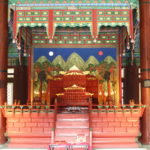
The principal seat of the Joseon dynasty, however, was Seoul, where several palaces occupy many hectares of the city. The traditional royal throne incorporates the city’s terrain. The royal red seating is adorned with golden dragons of good fortune. The white sun and the red moon shine protectively over a lush symbolic landscape of five hills, flowing rivers and elegant trees.

The two principal palaces in Seoul are quite different: Gyeongbokgung has more interesting buildings and history, while Changdeokgung has nicer grounds. Several other palaces compete for your attention as well. Several times a day at Gyeongbokgung, sporting colorful costumes and banners, the guards are changed to music delivered by drum and horns.
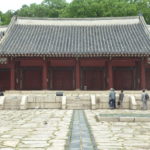
Near Gyeongbokgung Palace, Jongmyodaeje, is the current location of memorial tablets for the Joseon kings, along with collections of ritual objects to celebrate them. Each has his own cabana in an elongated building. Once a year, the cabanas are opened so that the tablets can parade about. We were fortunate to peak into several during the preparations on the day before.
Yet, for all the grandeur of Seoul’s palaces and the presence of the tablets at Jongmyodaeje, we felt closer to the Joseon spirits with the ancient houses of the quieter streets of Jeonju or, even more so, in the mists of Yangdong.
(Also, for more pictures from Korea, CLICK HERE to view the slideshow at the end of the itinerary page.)


